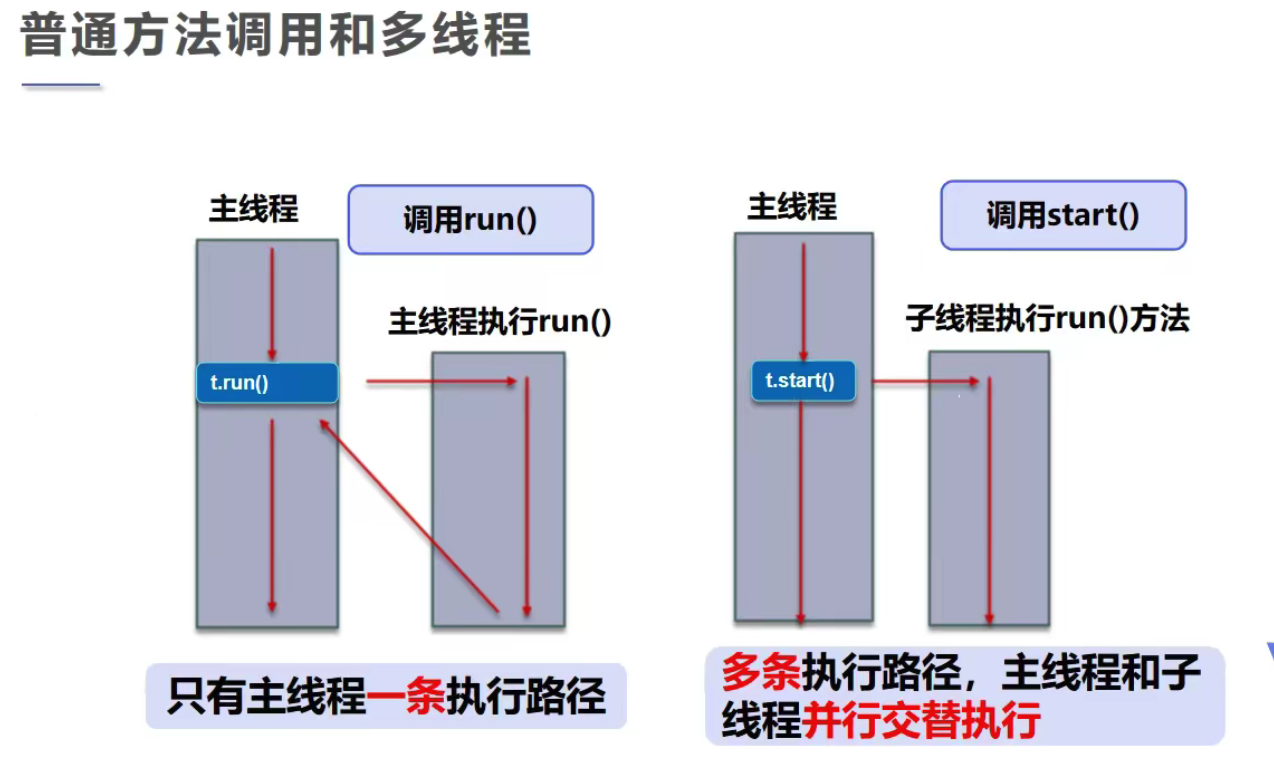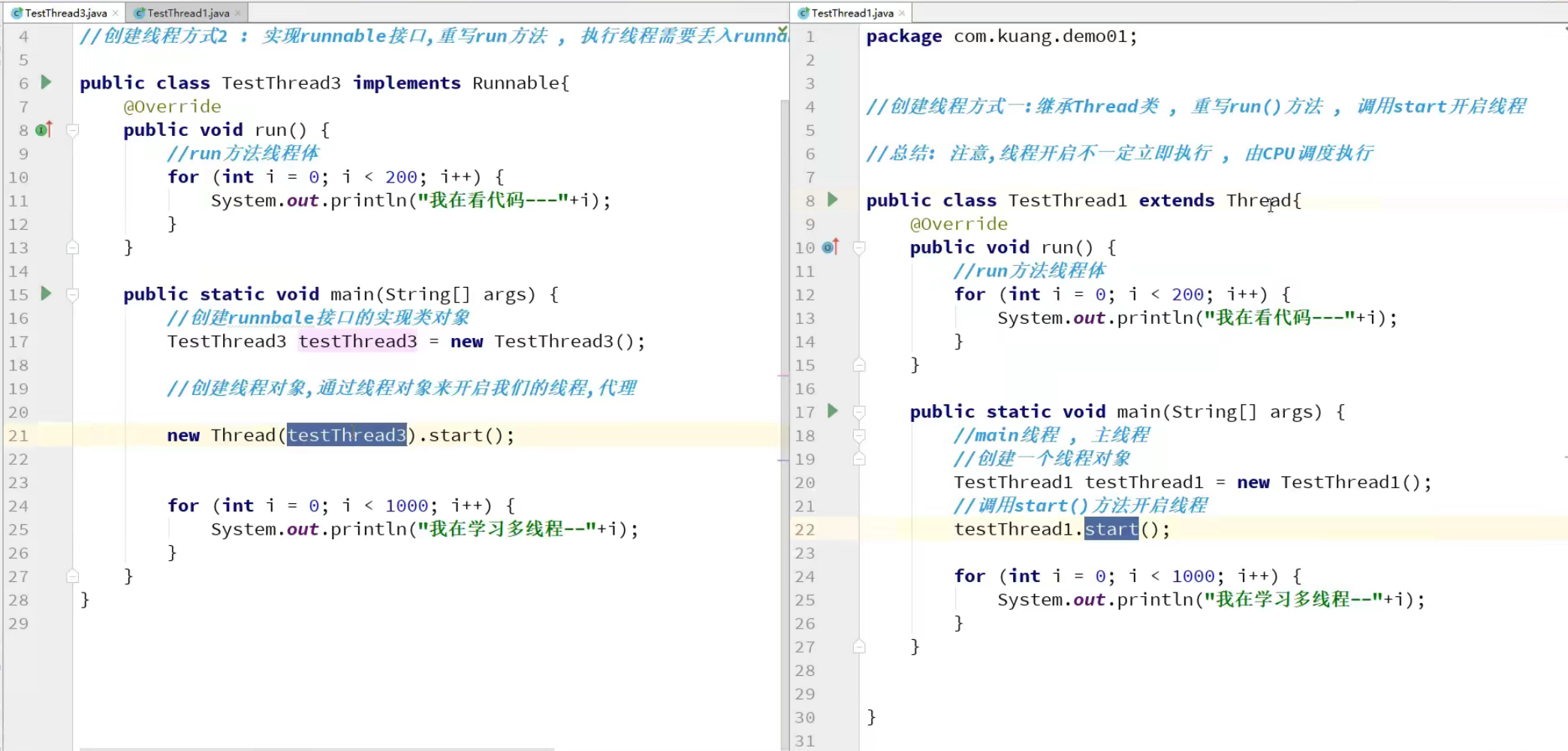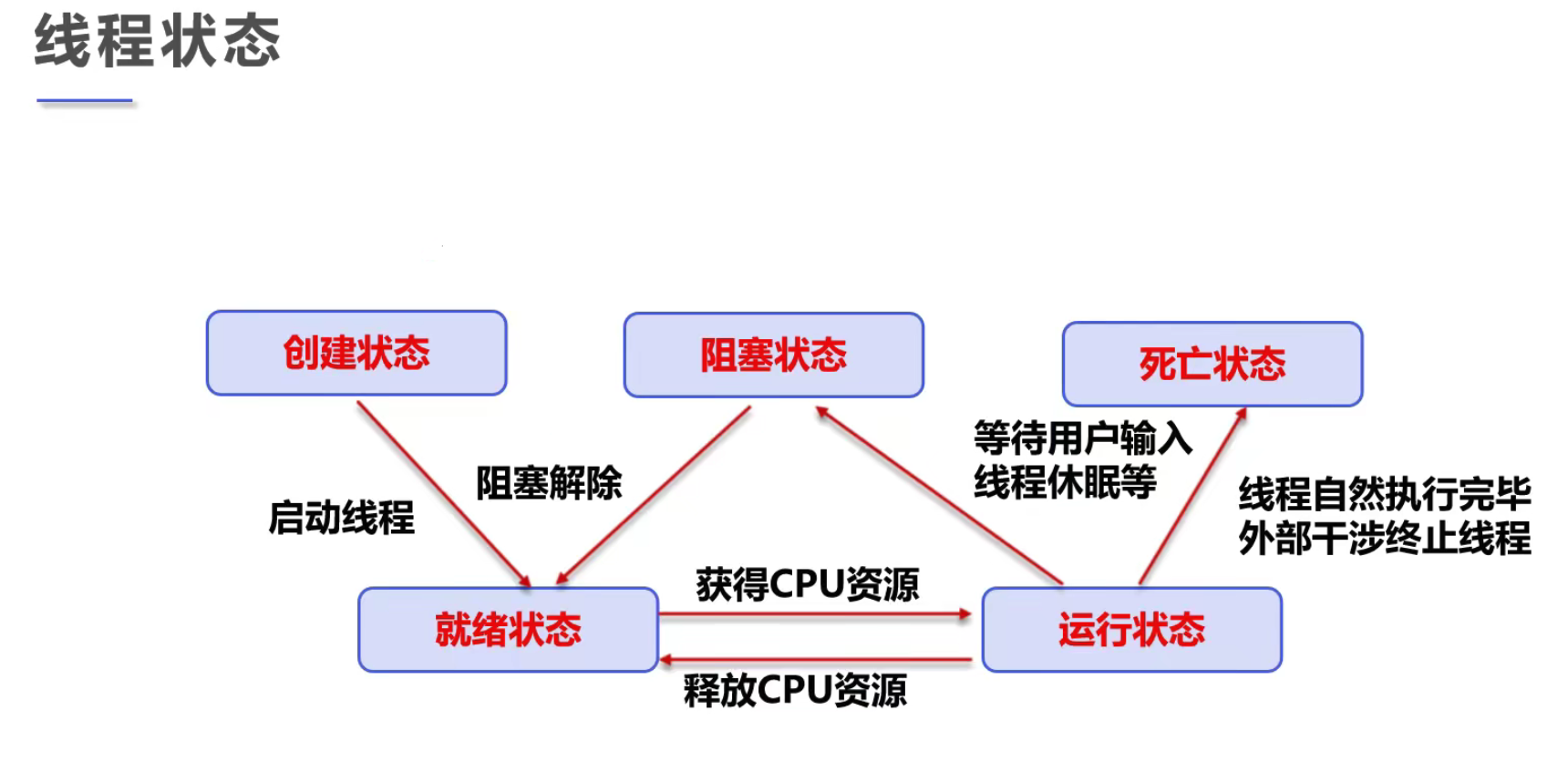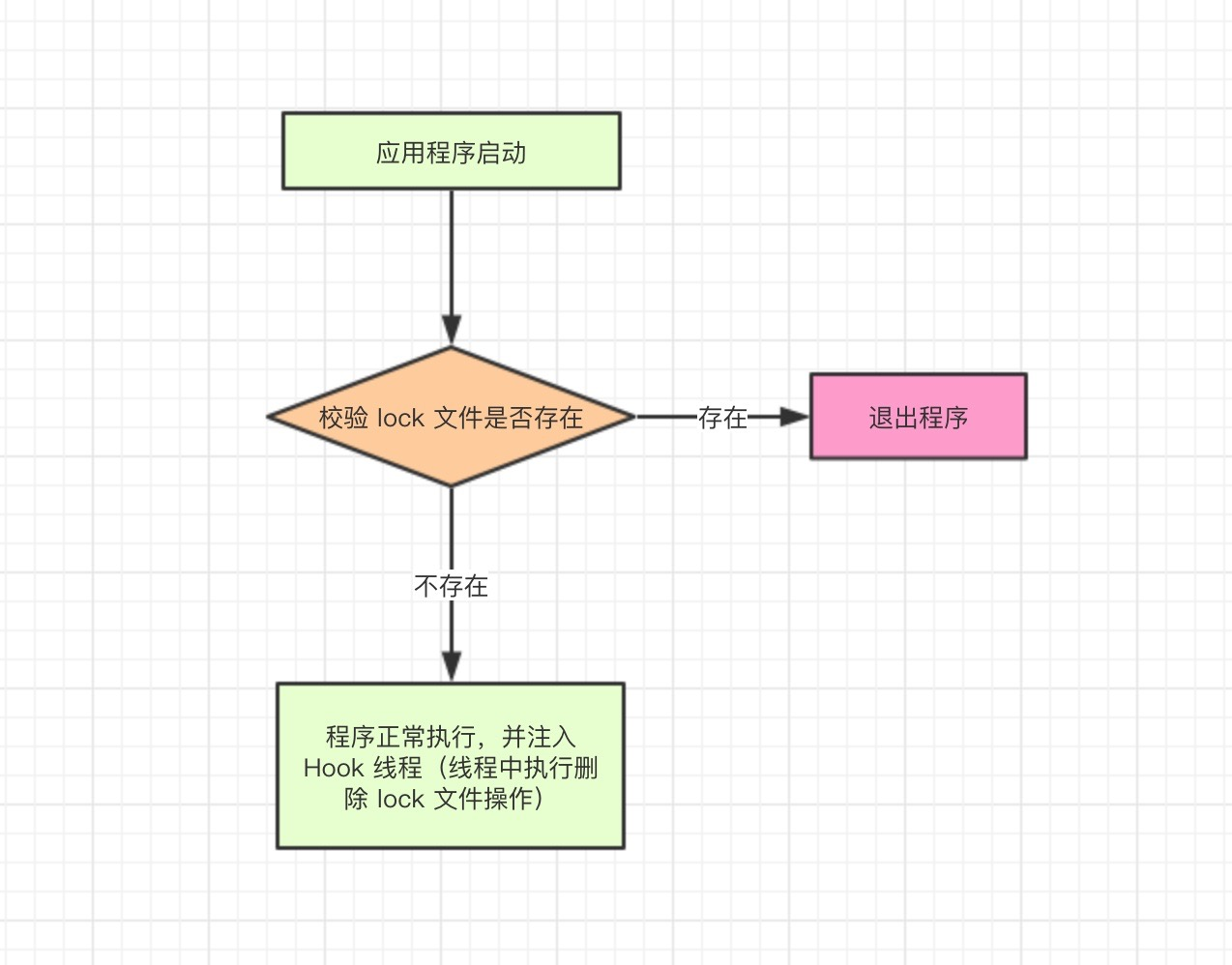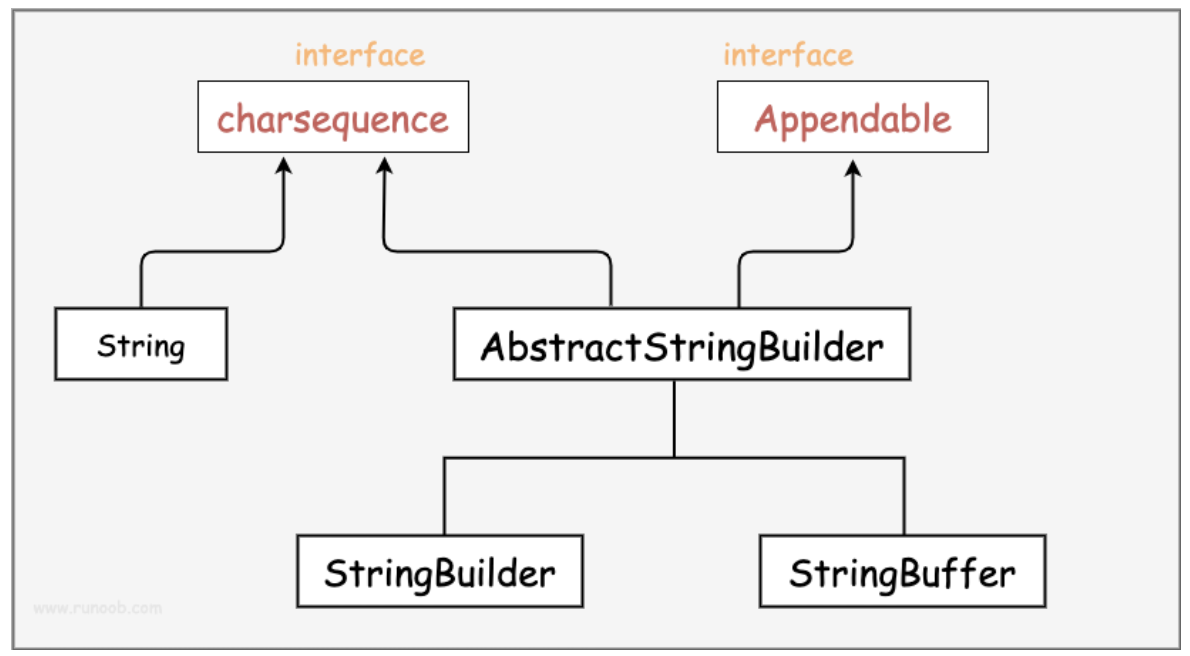Java多线程 学习资源:
多线程-JAVA进阶之路 《Java高并发编程详解》 汪文君 public class testThread extends Thread @Override public void run () for (int i = 0 ; i < 200 ; i++) { System.out.println("当前事件" + i); } } public static void main (String[] args) testThread tt = new testThread(); tt.start(); for (int i = 0 ; i < 200 ; i++) { System.out.println("=+++其他事件+++" + i); } } }
Thread类和Runnable接口实现多线程的区别
应尽可能使用Runnable接口 启动线程: 传入目标对象+Thread对象.start() 可以避免继承Thread类出现的单继承局限性,灵活方便,方便同一个对象被多个线程使用 StartThread station = new StartThread(); new Thread(station, "Jack" ).start();new Thread(station, "David" ).start();new Thread(station, "Mary" ).start();
Runnable 接口 public class TestThread2 implements Runnable @Override public void run () for (int i = 0 ; i < 20 ; i++) { System.out.println("当前事件" + i); } } public static void main (String[] args) TestThread2 tt3 = new TestThread2(); new Thread(tt3).start(); for (int i = 0 ; i < 20 ; i++) { System.out.println("=+++其他事件+++" + i); } } }
Runnable public class TestThread3 implements Runnable private int ticketNums = 10 ; @Override public void run () while (true ){ if (ticketNums <= 0 ){ break ; } try { Thread.sleep(200 ); } catch (InterruptedException e) { e.printStackTrace(); } System.out.println(Thread.currentThread().getName() + "---> get ticket:" + ticketNums); } } public static void main (String[] args) TestThread3 ticket = new TestThread3(); new Thread(ticket, "java" ).start(); new Thread(ticket, "python" ).start(); new Thread(ticket, "C++" ).start(); } }
龟兔赛跑 public class Race implements Runnable private static String winner; @Override public void run () for (int i = 0 ; i <= 100 ; i++) { if (Thread.currentThread().getName().equals("兔子" ) && i % 10 ==0 ){ try { Thread.sleep(10 ); } catch (InterruptedException e) { e.printStackTrace(); } } boolean flag = gameOver(i); if (flag){ break ; } System.out.println(Thread.currentThread().getName() + "---> 跑了" + i + "步" ); } } private boolean gameOver (int steps) if (winner != null ){ return true ; }{ if (steps >= 100 ){ winner = Thread.currentThread().getName(); System.out.println("winner is" + winner); return true ; } } return false ; } public static void main (String[] args) Race race = new Race(); new Thread(race, "兔子" ).start(); new Thread(race, "乌龟" ).start(); } }
静态代理 public class StaticProxy public static void main (String[] args) WeddingCompany wc = new WeddingCompany(new You()); wc.HappyMarry(); } } interface Marry void HappyMarry () } class You implements Marry @Override public void HappyMarry () System.out.println("you get married!" ); } } class WeddingCompany implements Marry private Marry target; public WeddingCompany (Marry target) this .target = target; } @Override public void HappyMarry () before(); this .target.HappyMarry(); after(); } private void after () System.out.println("收尾款,给好评" ); } private void before () System.out.println("收尾款,给好评" ); } }
优化代码 public class TestLambda1 static class Like2 implements ILike @Override public void lambda () System.out.println("I like lambda2!" ); } } static class Like implements ILike @Override public void lambda () System.out.println("I like lambda!" ); } } public static void main (String[] args) ILike like = new Like(); like.lambda(); like = new Like2(); like.lambda(); class Like3 implements ILike @Override public void lambda () System.out.println("I like lambda3!" ); } } like = new Like3(); like.lambda(); like = new ILike() { @Override public void lambda () System.out.println("I like lambda4!" ); } }; like.lambda(); like = () -> System.out.println("I like lambda5!" ); like.lambda(); ILove love = null ; love = (name) -> System.out.println("I love " + name); love.love(123 ); } } interface ILike void lambda () } interface ILove void love (int name) } class Like implements ILike @Override public void lambda () System.out.println("I like lambda!" ); } }
线程停止
public class TestStop implements Runnable private boolean flag = true ; @Override public void run () int i = 0 ; while (flag){ System.out.println("run ...... Thread: " + i++); } } public void stop () this .flag = false ; } public static void main (String[] args) TestStop ts = new TestStop(); new Thread(ts).start(); for (int i = 0 ; i < 1000 ; i++) { System.out.println("main" + i); if (i == 900 ){ ts.stop(); System.out.println("线程停止了!" ); } } } }
线程休眠 sleep进程进入阻塞 时间是按毫秒计算的,1000ms = 1s sleep存在异常InterruptedException sleep时间到,线程进入就绪态 sleep可以模拟网络延时、倒计时 每一个对象都有一个锁,sleep不会释放锁 public class TestSleep implements Runnable private int ticketNums = 10 ; @Override public void run () while (true ) { if (ticketNums <= 0 ){ break ; } try { Thread.sleep(1000 ); }catch (InterruptedException e){ e.getStackTrace(); } System.out.println(Thread.currentThread().getName() + "---> 拿到了第" + ticketNums-- + "票" ); } } public static void main (String[] args) TestSleep ticket = new TestSleep(); new Thread(ticket, "小明" ).start(); new Thread(ticket, "老师" ).start(); new Thread(ticket, "黄牛党" ).start(); } }
yield public class TestYield public static void main (String[] args) MyYield my = new MyYield(); new Thread(my, "a" ).start(); new Thread(my, "b" ).start(); } } class MyYield implements Runnable @Override public void run () System.out.println(Thread.currentThread().getName() + "线程开始执行" ); Thread.yield(); System.out.println(Thread.currentThread().getName() + "线程停止执行" ); } }
线程强制执行 join 线程插入到主线程前面,主线程阻塞,当线程执行结束后主线程恢复 public class TestJoin implements Runnable public static void main (String[] args) throws InterruptedException TestJoin tj = new TestJoin(); Thread thread = new Thread(tj); thread.start(); for (int i = 0 ; i < 1000 ; i++) { if (i == 800 ){ thread.join(); System.out.println("main..." + i); } } } @Override public void run () for (int i = 0 ; i < 100 ; i++) { System.out.println("join vip!!!!..." + i); } } }
观察线程状态 public class TestState public static void main (String[] args) throws InterruptedException Thread thread = new Thread(() -> { for (int i = 0 ; i < 5 ; i++) { try { Thread.sleep(1000 ); } catch (InterruptedException e) { e.printStackTrace(); } } System.out.println("///////////" ); }); Thread.State state = thread.getState(); System.out.println(state); thread.start(); state = thread.getState(); System.out.println(state); while (state != Thread.State.TERMINATED){ Thread.sleep(100 ); state = thread.getState(); System.out.println(state); } } }
线程的优先级 Java默认的线程优先级为5 ,线程的执行顺序由调度程序来决定,线程的优先级会在线程被调用之前设定。 通常情况下,高优先级的线程将会比低优先级的线程有更高的几率 得到执行。
Thread.MIN_PRIORITY = 1; Thread.MAX_PRIORITY = 10; Thread.NORM_PRIORITY = 5;
getPriority() setPriority(int ***)
public class TestPriority implements Runnable @Override public void run () System.out.println(Thread.currentThread().getName() + "---" + Thread.currentThread().getPriority()); } public static void main (String[] args) System.out.println("主线程" + "---" + Thread.currentThread().getPriority()); TestPriority test = new TestPriority(); Thread t1 = new Thread(test); Thread t2 = new Thread(test); Thread t3 = new Thread(test); Thread t4 = new Thread(test); t1.start(); t2.setPriority(5 ); t2.start(); t3.setPriority(10 ); t3.start(); t4.setPriority(4 ); t4.start(); } }
Output:
主线程---5 Thread-0---5 Thread-1---5 Thread-2---10 Thread-3---4
守护线程 daemon 线程分为用户线程 和守护线程 。虚拟机必须确保用户线程执行完毕,虚拟机不用等待守护线程执行完毕,例如后台记录操作日志,监控日志,垃圾回收等待。
JVM 程序在什么情况下能够正常退出?
The Java Virtual Machine exits when the only threads running are all daemon threads.
当 JVM 中不存在任何一个正在运行的非守护线程时,则 JVM 进程即会退出。
import java.util.concurrent.TimeUnit;public class TestDaemon1 public static void main (String[] args) throws InterruptedException Thread thread = new Thread(() -> { while (true ){ try { TimeUnit.SECONDS.sleep(1 ); System.out.println("I am running..." ); }catch (InterruptedException e){ e.printStackTrace(); } } }); thread.start(); TimeUnit.SECONDS.sleep(2 ); System.out.println("The main thread ready to exit..." ); } }
Output:
线程无法退出:
I am running... The main thread ready to exit... I am running... I am running... I am running... I am running... I am running... I am running... I am running...
守护进程的方法 import java.util.concurrent.TimeUnit;import java.util.concurrent.TimeoutException;public class TestDaemon2 public static void main (String[] args) throws InterruptedException Runtime.getRuntime() .addShutdownHook(new Thread(() -> System.out.println("The JVM exit success" ))); Thread thread = new Thread(() -> { while (true ){ try { TimeUnit.SECONDS.sleep(1 ); System.out.println("I am running..." ); }catch (InterruptedException e){ e.printStackTrace(); } } }); thread.setDaemon(true ); thread.start(); TimeUnit.SECONDS.sleep(2 ); System.out.println("The main thread ready to exit..." ); } }
Output:
I am running... The main thread ready to exit... The JVM exit success
可以看到,当主线程退出时,JVM 会随之退出运行,守护线程同时也会被回收,即使你里面是个死循环也不碍事。
钩子进程 来源: Java 多线程之 Hook (钩子) 线程
通常情况下,我们可以向应用程序注入一个或多个 Hook (钩子) 线程,这样,在程序即将退出的时候,也就是 JVM 程序即将退出的时候,Hook 线程就会被启动执行 。
一些常见应用场景:
防止程序重复执行 ,具体实现可以在程序启动时,校验是否已经生成 lock 文件,如果已经生成,则退出程序,如果未生成,则生成 lock 文件,程序正常执行,最后再注入 Hook 线程,这样在 JVM 退出的时候,线程中再将 lock 文件删除掉;
PS: 这种防止程序重复执行的策略,也被应用于 Mysql 服务器,zookeeper, kafka 等系统中。
Hook 线程中也可以执行一些资源释放 的操作,比如关闭数据库连接,Socket 连接等
线程同步 当遇到同一个资源,多个人想要使用的情况时,最天然的解决办法就是排队。处理多线程问题时,多个线程访问同一个对象,并且某些线程还要修改对象。此时就需要线程同步 。线程同步实际上是一种等待机制,多个需要同时访问此对象的线程要进入此对象的等待池 队列,等待前面的线程使用完毕(每个对象都有一把锁),下一个线程再开始使用。
线程同步的应用场景就是多个线程操作同一个资源。
上下文切换
上下文切换(有时也称做进程切换或任务切换)是指 CPU 从一个进程(或线程)切换到另一个进程(或线程)。上下文是指某一时间点 CPU 寄存器和程序计数器的内容。 (有时也称做进程切换或任务切换)是指 CPU 从一个进程(或线程)切换到另一个进程(或线程)。上下文是指某一时间点 CPU 寄存器和程序计数器的内容。
并发 由于同一个进程的多个线程共享同一块存储空间 ,在带来方便的同时,也带来了访问冲突问题,为了保证数据在方法中被访问时的正确性,在访问时加入锁机制 Synchronized ,当一个线程获得对象的排它锁,独占资源,其他线程必须等待,使用后释放锁即可,存在以下问题:
一个线程持有锁会导致进程的其他线程挂起; 在多线程竞争下,加锁、释放锁会导致比较多的上下文切换 和调度延时,引起性能问题; 如果一个优先级高的线程等待一个优先级低的线程释放锁,会导致优先级倒置,引起性能问题。 要针对方法提出一套机制,这套机制就是synchronized 关键字,它包括两种用法synchronized 方法和synchronized块
public synchronized void method(int args) {}
使用线程同步锁的三个方法:
使用使用synchronized同步锁锁住方法 使用synchronized同步锁锁住变化的参数 使用Lock同步锁
缺陷: 若将一个大的方法申明微synchronized会大大影响效率。因为方法里面需要修改的内容才需要锁,锁太多就影响效率了。
锁方法 public class SafeDrawMoney public static void main (String[] args) Account account = new Account(100 , "旅行基金" ); Drawing you = new Drawing(account, 50 ,"你" ); Drawing gf = new Drawing(account, 100 , "你老婆" ); you.start(); gf.start(); } } class Account int money; String name; public Account (int money, String name) this .money = money; this .name = name; } } class Drawing extends Thread Account account; int drawingMoney; int nowMoney; public Drawing (Account account, int drawingMoney, String name) super (name); this .account = account; this .drawingMoney = drawingMoney; } @Override public void run () synchronized (account){ if (account.money - drawingMoney < 0 ){ System.out.println(Thread.currentThread().getName()+"余额不足" ); return ; } account.money = account.money - drawingMoney; nowMoney = nowMoney + drawingMoney; System.out.println(account.name+"余额为:" + account.money); System.out.println(this .getName() + "手里的钱:" + account.money); } } }
锁变量 public class SafeBuyTicket implements Runnable private int ticketNums = 10 ; boolean flag = true ; @Override public void run () while (flag){ try { buy(); } catch (InterruptedException e) { e.printStackTrace(); } } } public synchronized void buy () throws InterruptedException if (ticketNums <= 0 ){ flag = false ; return ; } Thread.sleep(100 ); System.out.println(Thread.currentThread().getName() + "买到第" + ticketNums-- + "张票" ); } public static void main (String[] args) SafeBuyTicket ticket = new SafeBuyTicket(); new Thread(ticket, "老人" ).start(); new Thread(ticket, "小孩" ).start(); new Thread(ticket, "黄牛党" ).start(); } }
锁集合 import java.util.ArrayList;import java.util.List;public class SafeList public static void main (String[] args) List<String> list = new ArrayList<>(); for (int i = 0 ; i < 10000 ; i++) { new Thread(() ->{ synchronized (list){ list.add(Thread.currentThread().getName()); } }).start(); } try { Thread.sleep(3000 ); }catch (InterruptedException e){ e.printStackTrace(); } System.out.println(list.size()); } }
多线程使用集合时推荐使用CopyOnWriteArrayList ,它适合用在“读多,写少”的“并发”应用中,是线程安全的
import java.util.concurrent.CopyOnWriteArrayList;public class TestJUC public static void main (String[] args) CopyOnWriteArrayList<String> list = new CopyOnWriteArrayList<>(); for (int i = 0 ; i < 10000 ; i++) { new Thread(() -> { list.add(Thread.currentThread().getName()); }).start(); } try { Thread.sleep(1000 ); }catch (InterruptedException e){ e.printStackTrace(); } System.out.println(list.size()); } }
死锁 多个线程各自占有一些共享资源,并且互相等待其他线程占有的资源才能运行,而导致两个或多个线程都在等待对方释放资源,都会停止执行的情况,某一个同步块同时拥有“两个以上对象的锁 ”时,就有可能发生死锁的问题
也就是多个线程互相拿着对方需要的资源,然后形成僵持
解决方法:同一个代码块不能同时报两把锁
产生死锁的四个必要条件:
(1) 互斥条件:一个资源每次只能被一个进程使用。
(2) 请求与保持条件:一个进程因请求资源而阻塞时,对已获得的资源保持不放。
(3) 不剥夺条件: 进程已获得的资源,在末使用完之前,不能强行剥夺。
(4) 循环等待条件: 若干进程之间形成一种头尾相接的循环等待资源关系。
会产生死锁的情况 public class DeadLock public static void main (String[] args) Makeup girl1 = new Makeup(0 , "mary" ); Makeup girl2 = new Makeup(1 , "daisy" ); girl1.start(); girl2.start(); } } class Makeup extends Thread static LipStick lipstick = new LipStick(); static Mirror mirror = new Mirror(); int choice; String girlName; Makeup(int choice, String girlName){ this .choice = choice; this .girlName = girlName; } @Override public void run () try { makeup(); } catch (InterruptedException e) { e.printStackTrace(); } } private void makeup () throws InterruptedException if (choice == 0 ){ synchronized (lipstick){ System.out.println(this .girlName + " get lipstick's lock" ); Thread.sleep(1000 ); synchronized (mirror){ System.out.println(this .girlName + " get mirror's lock" ); } } }else { synchronized (mirror) { System.out.println(this .girlName + " get mirror's lock" ); Thread.sleep(1000 ); synchronized (lipstick) { System.out.println(this .girlName + " get lipstick's lock" ); } } } } } class Mirror } class LipStick }
output:
mary get lipstick's lock daisy get mirror's lock
消除死锁的情况 public class DeadLock public static void main (String[] args) Makeup girl1 = new Makeup(0 , "mary" ); Makeup girl2 = new Makeup(1 , "daisy" ); girl1.start(); girl2.start(); } } class Makeup extends Thread static LipStick lipstick = new LipStick(); static Mirror mirror = new Mirror(); int choice; String girlName; Makeup(int choice, String girlName){ this .choice = choice; this .girlName = girlName; } @Override public void run () try { makeup(); } catch (InterruptedException e) { e.printStackTrace(); } } private void makeup () throws InterruptedException if (choice == 0 ){ synchronized (lipstick){ System.out.println(this .girlName + " get lipstick's lock" ); Thread.sleep(1000 ); } synchronized (mirror){ System.out.println(this .girlName + " get mirror's lock" ); } }else { synchronized (mirror) { System.out.println(this .girlName + " get mirror's lock" ); Thread.sleep(1000 ); } synchronized (lipstick) { System.out.println(this .girlName + " get lipstick's lock" ); } } } } class Mirror } class LipStick }
output:
mary get lipstick's lock daisy get mirror's lock mary get mirror's lock daisy get lipstick's lock
Lock锁 从jdk5.0开始,java提供了更轻大的线程同步机制,通过显式定义同步锁对象来实现同步,同步锁使用lock对象充当
lock接口是控制多个线程对共享资源进行访问的工具
锁提供了对共享资源的独占访问,每次只能有一个线程对lock对象加锁,线程开始访问共享资源之前应先获得lock对象
ReentranLock类实现了Lock,它拥有与Synchronized相同的并发性和内存语义,在实现线程安全的控制中,比较常用的是 ReentrantLock,可以显式加锁,释放锁
不安全的多线程 public class TestLock public static void main (String[] args) TestLock2 tl = new TestLock2(); new Thread(tl).start(); new Thread(tl).start(); new Thread(tl).start(); } } class TestLock2 implements Runnable int ticketNums = 10 ; @Override public void run () while (true ){ if (ticketNums > 0 ){ try { Thread.sleep(1000 ); }catch (InterruptedException e){ e.printStackTrace(); } System.out.println(ticketNums--); }else { break ; } } } }
安全的锁 import java.util.concurrent.locks.ReentrantLock;public class TestLock public static void main (String[] args) TestLock3 tl = new TestLock3(); new Thread(tl).start(); new Thread(tl).start(); new Thread(tl).start(); } } class TestLock3 implements Runnable int ticketNums = 10 ; private final ReentrantLock lock = new ReentrantLock(); @Override public void run () while (true ){ lock.lock(); try { if (ticketNums > 0 ){ try { Thread.sleep(1000 ); }catch (InterruptedException e){ e.printStackTrace(); } System.out.println(ticketNums--); }else { break ; } }finally { lock.unlock(); } } } }
Synchronized与Lock的对比 Lock是显示锁 (手动开启和关闭锁,别忘记关闭锁)
Synchronized是隐式锁 ,出来作用域自动释放
Lock只有代码块锁
Synchronized有代码块和方法锁
使用Lock锁,JVM将花费较少的时间来调度线程,性能更好,并且具有更好的扩展性(提供更多子类)
Lock > 同步代码块(已经进入了方法体,分配了相应的资源) > 同步方法(在方法体之外)
线程协作 线程通信:等待、通知
生产者消费者问题 在生产者消费者问题中,仅有Synchronized是不够的
Synchronized可阻止并发更新同一个共享资源,实现了同步 Synchronized不能用来实现不同线程之间的消息传递(通信) JAVA提供了几个方法解决线程之间的通讯问题
方法名 作用 wait() 表示线程一直等待,直到其他线程通知,与sleep不同,会释放锁 wait(long tiomeout) 指定等待的毫秒数 notify() 唤醒一个处于等待状态的线程 notifyAll() 唤醒同一个对象上所有调用wait()方法的线程,优先级别高的线程优先调度
注意: 均是Object类的方法,都只能在同步方法或同步代码块中使用,否则会抛出异常IIIegalMonitorStateException
解决方法 管程法
i. 生产者将生产好的数据放入数据缓存区,消费者从缓存区取出数据
信号灯法
i. 生产者/消费者查看信号判断是否可以存/取数据
管程法 public class TestPC public static void main (String[] args) Container container = new Container(); new Productor(container).start(); new Consumer(container).start(); } } class Productor extends Thread Container container; public Productor (Container container) this .container = container; } @Override public void run () for (int i = 0 ; i < 100 ; i++) { container.push(new Chicken(i)); System.out.println("生产了第 " +i+" 只鸡!" ); } } } class Consumer extends Thread Container container; public Consumer (Container container) this .container = container; } @Override public void run () for (int i = 0 ; i < 100 ; i++) { System.out.println("消费了第 " + container.pop().id+" 只鸡" ); } } } class Chicken int id; public Chicken (int id) this .id = id; } } class Container Chicken[] chickens = new Chicken[10 ]; int count = 0 ; public synchronized void push (Chicken chicken) if (count == chickens.length){ try { this .wait(); } catch (InterruptedException e) { e.printStackTrace(); } } chickens[count] = chicken; count++; this .notifyAll(); } public synchronized Chicken pop () if (count == 0 ){ try { this .wait(); } catch (InterruptedException e) { e.printStackTrace(); } } count--; Chicken chicken = chickens[count]; this .notifyAll(); return chicken; } }
Output:
…… 生产了第 27 只鸡! 生产了第 28 只鸡! 生产了第 29 只鸡! 生产了第 30 只鸡! 生产了第 31 只鸡! 消费了第 22 只鸡 消费了第 32 只鸡 消费了第 31 只鸡 消费了第 30 只鸡 ……
信号灯法 public class TestPC2 public static void main (String[] args) TV tv = new TV(); new Player(tv).start(); new Watcher(tv).start(); } } class Player extends Thread TV tv; public Player (TV tv) this .tv = tv; } @Override public void run () for (int i = 0 ; i < 20 ; i++) { if (i % 2 == 0 ){ this .tv.play("播放中国好声音" ); }else { this .tv.play("播放新闻联播" ); } } } } class Watcher extends Thread TV tv; public Watcher (TV tv) this .tv = tv; } @Override public void run () for (int i = 0 ; i < 20 ; i++) { tv.watch(); } } } class TV String voice; boolean flag = true ; public synchronized void play (String voice) if (!flag){ try { this .wait(); }catch (InterruptedException e){ e.printStackTrace(); } } System.out.println("演员表演了 " + voice); this .notifyAll(); this .voice = voice; this .flag = !this .flag; } public synchronized void watch () if (flag){ try { this .wait(); } catch (InterruptedException e) { e.printStackTrace(); } } System.out.println("观众观看了 " +voice); this .notifyAll(); this .flag = !this .flag; } }
output:
演员表演了 播放中国好声音 观众观看了 播放中国好声音 演员表演了 播放新闻联播 观众观看了 播放新闻联播 演员表演了 播放中国好声音 观众观看了 播放中国好声音 演员表演了 播放新闻联播 观众观看了 播放新闻联播
线程池 背景:经常创建和销毁,使用量特别大的资源,比如并发情况下的线程,对性能影响很大
思路:提前创建好多个线程,放入线程池中,使用时直接获取,使用完放回池中。可以避免频繁创建销毁,实现重复利用。类似生活中的公共交通工具
好处:提高相应速度(减少了创建新线程的时间)
降低资源消耗(重复利用线程池中线程,不需要每次都创建)
便于线程管理
corePoolSize:核心池的大小 maxinumPoolSize:最大线程数 keepAliveTime: 线程没有任务时最多保持多长时间后会终止 import java.util.concurrent.ExecutorService;import java.util.concurrent.Executors;public class TestPool public static void main (String[] args) ExecutorService service = Executors.newFixedThreadPool(10 ); service.execute(new MyThread()); service.execute(new MyThread()); service.execute(new MyThread()); service.execute(new MyThread()); service.shutdown(); } } class MyThread implements Runnable @Override public void run () System.out.println(Thread.currentThread().getName()); } }
output:
pool-1-thread-1 pool-1-thread-4 pool-1-thread-3 pool-1-thread-2
以上为入门java多线程所有内容
项目代码位置: https://github.com/Leekinghou/JavaCoreTechnology
